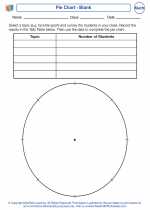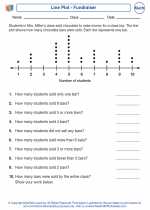Rotational Symmetry
Rotational symmetry is a concept in geometry that describes the property of an object to look the same after a certain amount of rotation. When an object has rotational symmetry, it means that it can be rotated by a certain angle and still appear unchanged.
Key Concepts
- Rotation: Rotational symmetry refers to the ability of an object to be rotated by a certain angle and still look the same.
- Order of Rotational Symmetry: The order of rotational symmetry of an object is the number of times it can be rotated in a full circle and still look unchanged.
- Rotational Symmetry Axis: The axis around which an object can be rotated to achieve symmetry.
Examples
Some examples of objects with rotational symmetry include:
- A regular polygon, such as a square, has rotational symmetry of order 4, as it can be rotated by 90 degrees four times and still look the same.
- A circle has infinite rotational symmetry, as it can be rotated by any angle and still look the same.
Practice Problems
Test your understanding of rotational symmetry with the following practice problems:
- What is the order of rotational symmetry for a regular hexagon?
- Does a rectangle have rotational symmetry? If so, what is its order of rotational symmetry?
Answers
- The order of rotational symmetry for a regular hexagon is 6, as it can be rotated by 60 degrees six times and still look the same.
- Yes, a rectangle has rotational symmetry. It has an order of rotational symmetry of 2, as it can be rotated by 180 degrees twice and still look the same.
[Rotational Symmetry] Related Worksheets and Study Guides:
.◂Math Worksheets and Study Guides Fourth Grade. Tables and Graphs
Study Guide Tables and Graphs
Tables and Graphs  Activity Lesson
Activity Lesson Pie Chart - Blank
Pie Chart - Blank  Activity Lesson
Activity Lesson Classroom Chaos
Classroom Chaos  Activity Lesson
Activity Lesson Mary`s Many Movements
Mary`s Many Movements  Worksheet/Answer key
Worksheet/Answer key Tables and Graphs
Tables and Graphs  Worksheet/Answer key
Worksheet/Answer key Tables and Graphs
Tables and Graphs  Worksheet/Answer key
Worksheet/Answer key Tables and Graphs
Tables and Graphs  Worksheet/Answer key
Worksheet/Answer key Tables and Graphs
Tables and Graphs  Worksheet/Answer key
Worksheet/Answer key Tables and Graphs
Tables and Graphs  Worksheet/Answer key
Worksheet/Answer key Tables and Graphs
Tables and Graphs  Worksheet/Answer key
Worksheet/Answer key Student Pictograph
Student Pictograph  Worksheet/Answer key
Worksheet/Answer key Line Plot - Fundraiser
Line Plot - Fundraiser  Worksheet/Answer key
Worksheet/Answer key Pie Chart - After-School Activities
Pie Chart - After-School Activities 

 Activity Lesson
Activity Lesson
 Activity Lesson
Activity Lesson
 Activity Lesson
Activity Lesson
 Worksheet/Answer key
Worksheet/Answer key
 Worksheet/Answer key
Worksheet/Answer key
 Worksheet/Answer key
Worksheet/Answer key
 Worksheet/Answer key
Worksheet/Answer key
 Worksheet/Answer key
Worksheet/Answer key
 Worksheet/Answer key
Worksheet/Answer key
 Worksheet/Answer key
Worksheet/Answer key
 Worksheet/Answer key
Worksheet/Answer key
 Worksheet/Answer key
Worksheet/Answer key

The resources above cover the following skills:
DATA ANALYSIS
Interpret data displayed in a circle graph.